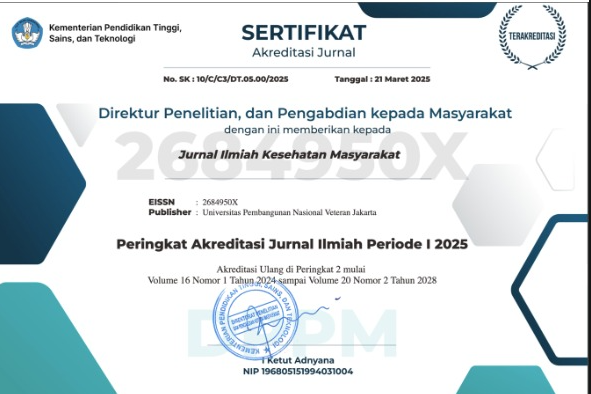Faktor-Faktor yang Berhubungan dengan Gejala Sick Building Syndrome (SBS)
Abstract
Abstrak
Latar Belakang: Sick Building Syndrome (SBS) merupakan kumpulan gejala yang dirasakan oleh orang-orang yang berada di dalam gedung. Manusia menghabiskan 70-80% waktunya di dalam ruangan, hal tersebut dapat menyebabkan masalah kesehatan seperti kelelahan dan berdampak pada efektifitas pada pekerjaan. Tujuan penelitian ini untuk mengetahui hubungan antara pendingin ruangan atau AC, ventilasi, pencahayaan, suhu, kelembaban, bising, umur, jenis kelamin, psikososial dan masa kerja dengan SBS.
Metode: Penelitian ini dilakukan dengan Studi Literature Review. Penelitian dilakukan dengan cara penelusuran data dengan topik faktor-faktor yang berhubungan dengan sick building syndrome seperti pencahayaan dan suhu. Penelusuran dilakukan melalui Google Scholar tahun 2013 – 2020.
Hasil: Hasil penelitian menunjukkan bahwa AC, ventilasi, psikososial, pencahayaan, suhu, kelembaban dan kebisingan, umur dan jenis kelamin, serta masa kerja merupakan faktor-faktor yang berhubungan secara signifikan dengan Sick building syndrome.
Kesimpula: hasil analisis menunjukkan adanya hubungan antara SBS dengan pendingin ruangan atau AC, ventilasi, pencahayaan, suhu, kelembaban, bising, umur, jenis kelamin, psikososial dan masa kerja. Saran pekerja melakukan olahraga secara teratur dan tidak melakukan pekerjaan yang berlebihan. Instansi terkait melakukan pemeriksaan dan perawatan secara rutin peralatan dan perlengkapan kerja.
Factors Related to Sick Building Syndrome (SBS)
Abstract
Background: Sick Building Syndrome (SBS) is a collection of symptoms felt by people living in a building. Indoors, people spend 70-80 per cent of their time, this can cause health issues like fatigue and affect productivity in the workplace. The purpose is determine whether a relationship exists between air conditioners, ventilation, lighting, temperature, humidity, noise, age, gender, psychosocial and work period with sick building syndrome.
Methods: This Study is a literature review study. The study that tracks data of factors related to sick building syndrome like lighting and temperature. The data tracking with Google Scholar published in 2013-2020.
Result: The results showed that air conditioning, ventilation, psychosocial conditions, lighting, temperature, humidity and noise, age and sex, and years of service were all factors that were significantly associated with Sick Building Syndrome.
Conclusion: The study showed a relationship between air conditioners, ventilation, lighting, temperature, humidity, noise, age, sex, psycho-social and work period with sick building syndrome. Reccomended to workers do daily exercise and do not unnecessary work. Routine inspection and repair of equipment and materials for work is carried out by the company.
References
Sumarni. Gambaran Kejadian Sick Building Syndrome (Sbs) pada Karyawan Fajar Group di Gedung PT. Fajar Graha Pena Makassar. 2012;
Fauzi M. Hubungan Faktor Fisik,Biologi Dan Karakteristik Individu Dengan Kejadian Sick Building Syndrome Pada Pegawai Di Gedung Pandanaran Kota Semarang. Fakultas Ilmu Keolahragaan Universitas Negeri Semarang. 2015. 1–65 p.
Kim J, Jang M, Choi K, Kim K. Perception of indoor air quality (IAQ) by workers in underground shopping centers in relation to sick-building syndrome (SBS) and store type: A cross-sectional study in Korea. BMC Public Health. 2019;19(1):1–9.
Puspawita M, Rahmah SP, Sari PN. Faktor yang Berhubungan dengan Sick Building Syndrome (SBS) pada Pegawai kantor Pusat PDAM Kota Padang Tahun 2019 Oleh : Mery Puspawita No . BP . 1511211055 Pembimbing II : Putri Nilam Sari , SKM , M . Kes. 2019;
Ikmala R, Ma’rufi I, Munawir A. Health Notions , Volume 2 Number 5 ( May 2018 ) Individual Characteristics , Antibody , Work Environment and Sick Building Syndrome ( SBS ) 546 | Publisher : Humanistic Network for Science and Technology Health Notions , Volume 2 Number 5 ( May 2018 ) 547. 2018;2(5):546–9.
Asri AN, Maharani R, Fitri AM. Hubungan Lingkungan Kerja Dengan Gejala Sick Building Syndrome Pada Pegawai BPJS Kesehatan Depok Tahun 2019. 2019;3(1):44–55.
Lu CY, Tsai MC, Muo CH, Kuo YH, Sung FC, Wu CC. Personal, psychosocial and environmental factors related to sick building syndrome in official employees of Taiwan. Int J Environ Res Public Health. 2018;15(1):1–9.
Smajlović SK, Kukec A, Dovjak M. Association between sick building syndrome and indoor environmental quality in slovenian hospitals: A cross-sectional study. Int J Environ Res Public Health. 2019;16(17).
Rahman NH, Naiem F, Russeng S. Studi tentang Keluhan Sick Building Syndrome (SBS) pada Pegawai di Gedung Rektorat Universitas Hasanuddin Makassar. J Fak Kesehat Masy [Internet]. 2014;1–12. Available from: http://repository.unhas.ac.id/bitstream/handle/123456789/8529/Jurnal Studi tentang Keluhan Sick Building Syndrom .pdf?sequence=1
Sari OS, Wahyuni D. Faktor-Faktor Yang Berhubungan Dengan Kejadian Sick Building Syndrome Pada Karyawan Di Gedung Sampoerna Strategic Pt Sampoerna Land Jakarta Tahun 2015. Artik Ilmu Kesehat. 2016;8(1):26–30.
Abdel-Hamid MA, A. Hakim S, Elokda EE, Mostafa NS. Prevalence and risk factors of sick building syndrome among office workers. J Egypt Public Health Assoc. 2013;88(2):109–14.
Taufiq, L. Faktor-faktor yang Berhubungan dengan Keluhan Sick Building Syndrom (SBS) pada Tenaga Kerja Di PT. X Gresik Tahun 2018. 2018;
Jafari MJ, Khajevandi AA, Najarkola SAM, Yekaninejad MS, Pourhoseingholi MA, Omidi L, et al. Association of sick building syndrome with indoor air parameters. Tanaffos. 2015;14(1):55–62.
Nopiyanti E, Susanto AJ, Sutabri T, Ridwan AM, Febrianti R. FACTORS RELATED TO SYMPTOMS SICK BUILDING SYNDROME IN EMPLOYEES AT OK UNIT OF MARINE HOSPITAL. 2019;362–73.
Saffanah S, Pulungan RM. Faktor Risiko Gejala Sick Building Syndrome Pada PEGAWAI BPPSDM KESEHATAN RI. J Ilmu Kesehat. 2017;3(1):8–15.
Rohizan, N. A. & Abidin EZ. Assessment on Physical Factors of Thermal Comfort, Sick Building Syndrome Symptoms and Perception of Comfort among Occupants in a Public Research University Laboratory Building. Int J Public Heal Clin Sci. 2015;2(3):59–70.
Raharjo HD, Wiediartini, Dermawan D. Analisis Pengaruh Karakteristik Individu dan Faktor Fisik Terhadap Gejala Sick Building Syndrome Pada Pegawai di Gedung Utama Perusahaan Fabrikasi Kapal. J Tek Keselam dan Kesehat Kerja. 2017;(2581):5–9.
Zaelani A. Faktor-faktor yang Mempengaruhi Kejadian Sick Building syndrome pada Pegawai di Departemen Distribusi Wilayah 1 Graha Sarana PT Petrokimia Gresik. 2015; Available from: http://repository.unej.ac.id/
Murniati N. Hubungan Suhu dan Kelembaban dengan Keluhan Sick Building Syndrome pada Petugas Administrasi Rumah Sakit Swasta X. J Ilmu Kesehat Masy. 2018;7(3):148–54.
Fard RF, Hosseini MR, Faraji M, Oskouei AO. Building characteristics and sick building syndrome among primary school students. Sri Lanka J Child Heal. 2018;47(4):332–7.
Arikan İ, Tekin ÖF, Erbas O. Relationship between sick building syndrome and indoor air quality among hospital staff. Med del Lav. 2018 Nov 1;109(6):435–43.
Jafari NS, Dehghani M. Signs and symptoms of sick-building syndrome among office workers of Bandar Abbas Municipality. undefined. 2016;
Keyvani S, Mohammadyan M, Mohamadi S, Etemadinezhad S. Sick Building Syndrome and Its Associating Factors at a Hospital in Kashan, Iran. Iran J Heal Sci. 2017 Apr 1;5(2):19–24.
Corie. Pengaruh Kualitas Udara Dalam Ruangan Ber AC Terhadap Gangguan Kesehatan. 2005;160–70.
Joshi S. The sick building syndrome. Indian J Occup Environ Med [Internet]. 2008 May 1 [cited 2020 Jun 11];12(2):61. Available from: http://www.ijoem.com/text.asp?2008/12/2/61/43262
Akinwale OM, Oluwunmi AO, Utom J, Fadahunsi J. A Review of the Effects of Sick Building Syndrome on Property and the Occupants. 2019;7(1):18–28.
Iyagba A. The Menace Of Sick Buildings: A Challenge To All for Its Prevention and Treatment. Inaug Lect Deliv Univ Lagos Main Audit. 2005;
Nduka DO, Amusan L, Akinbile B, Owolabi JD. Environmental physical quantities impact on emergence of sick building syndrome on users of public buildings in LAGOS, Nigeria. Int J Civ Eng Technol. 2018;9(10):980–90.
Rostron J. Sick building syndrome: A review of causes, consequences and remedies. J Retail Leis Prop. 2008;7(4):291–303.









.jpg)








